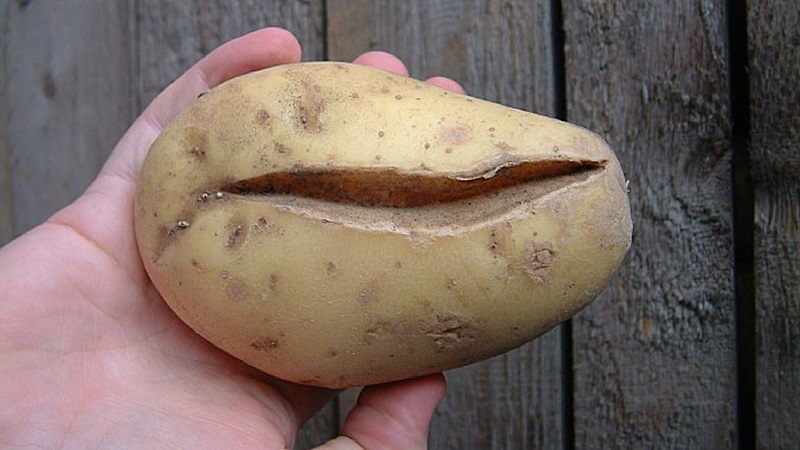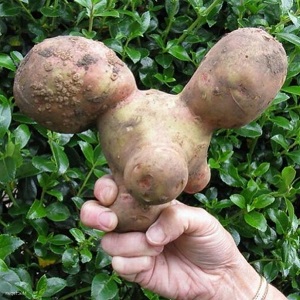What to do if the potato is ugly and gnarled, and why it happened
Ugly, gnarled, cracked potatoes - such a "surprise" will not please the gardener when harvesting. Tuber deformation is caused by a number of factors: from unfavorable weather to uneven watering.
Why potatoes become clumsy and ugly and whether it is possible to eat tubers-"mutants" - learn from the article.
The content of the article
Why potatoes crack, deform, and become ugly
There are many reasons for this phenomenon. At the same time, deformed tubers look different. - the exact symptomatology depends on the specific factor. When infected with diseases or pests, a complex of related signs appears.

Weather
The main reason why potatoes become clumsy is a sudden change in steady heat to prolonged showers and coolness.... A significant difference in temperature and volume of sunlight is a stressful situation: it is difficult for potatoes to adapt to changing conditions, which causes uneven growth of tubers. If, after showers, heat and drought sets in, the vegetable bursts, voids form inside it.
Diseases
Tuber deformity - a possible consequence of infection with viral or fungal infections... The problem is precisely determined by the presence of other signs of disease - spots, rot, yellowing of the potato ridge.
Diseases leading to deformation of tubers:
- common scab;
- blackleg;
- fomoz, or button rot.
Infected potatoes crack, rotting or rotting pulp is visible in the resulting opening.
Pests
Potato tubers are often attacked by a nematode - a microscopic parasitic worm... The pest lives in the soil, and multiplies on potato tubers. Infection leads to cracking, the formation of extensive dark spots. The pulp becomes rotten.
Reference! The appearance of nematodes is difficult to detect at an early stage. Symptoms become apparent only when the infection has already reached its peak, and the potato crop has undergone significant deformations.
Another dangerous pest is wireworm... This is the larva of a click beetle that lives in a potato tuber. The characteristic symptom of infection is the numerous passages in the potato.

Unsuitable soil
Potatoes occupy one of the leading places in terms of requirements for fertility, lightness and structure of the soil... The plant does not tolerate acidic soil. Small and ugly root crops grow on loam or clay soil - these are heavy and “choking” types. In such a soil, there are few nutrients, air does not come in well, water stagnates or dries out completely - which is why potato tubers are clumsy. They cannot develop normally, which leads to the formation of "mutants".
Take a note:
What fertilizers to apply in the fall after harvesting potatoes
Types of dressings when planting potatoes
The best potato varieties: "Naiada", "Madeira", "Chaika" and others
Improper watering
A long break in watering and pouring potato bushes are the main reasons the formation of ugly and uneven potatoes. Uneven water flow slows down growth, leads to the formation of a bizarre shape of tubers. Stagnant water leads to the onset of putrefactive processes.
Prevention of crookedness and ugliness of potatoes
Compliance with vegetation requirements, prevention and timely control of diseases and pests - basic rules to help avoid the problem of ugly tubers.
Correct cultivation technique
 Competent agricultural technology consists of several stages. The first is soil preparation. If the soil on the site is clayey and there is no way to change it, preliminary preparation is required. In the fall, rotted or fresh sawdust, urea or any other nitrogen-containing fertilizer are applied. Dig a shovel onto the bayonet.
Competent agricultural technology consists of several stages. The first is soil preparation. If the soil on the site is clayey and there is no way to change it, preliminary preparation is required. In the fall, rotted or fresh sawdust, urea or any other nitrogen-containing fertilizer are applied. Dig a shovel onto the bayonet.
To increase lightness and permeability, sand is added (preferably a rough river) - 1 bucket per 1 m². For deoxidation in autumn and spring, chalk, lime or wood ash is added to the ground before planting.
Important! Fresh manure must not be added to the soil. This is the source of the scab. Organic matter is introduced only in rotted form.
Only healthy specimens are planted without deformations and external pathologies... It is recommended to select varieties with high immunity. Before planting, they are treated against pests and diseases - soaking in a solution of "Fitosporin", "Integral" or "Baktofit".
Other recommendations:
- For disembarkation, select a well-lit area.
- Hilling - for the first time when the green mass grows up to 10 cm, the second - after 14 days, the third - before flowering.
- Two intensive waterings per season are enough for potato bushes (if there is no drought). The first is carried out 5-7 days after the emergence of seedlings, the second - at the beginning of the process of formation of tubers.
- Loosen the soil after each watering.
- Timely removal of weeds, especially sow thistle and wheatgrass. Their long and powerful roots pass through the tubers, remain inside. Also wheatgrass is a peddler wireworm.
Fighting disease
To prevent infection, after harvesting the site is sown with green manure (legumes or cereals). After reaching 10-15 cm, the garden is dug up. The remains of green manure in the soil will kill saprophytic fungi and pathogens.
Recommended pre-planting treatment of tubers with "Fitosporin"... Then, 3 times a season, potato bushes are treated for preventive purposes. Working solution - 1 sachet for 3 liters of water.
| Disease | Drugs for treatment |
| Scab | Means of strong action - "Mancozeb", "Kolfugo", "Fenoram super". |
| Blackleg | A popular variation of the treatment is garlic infusion. Pass 2-3 cloves through a press, add a glass of warm water, leave for 24 hours. Add 5 liters of clean water before spraying
Chemicals - "Fitosporin-M", "Vitaros", "Topsin-M", "Effekton", "Energen", "HOM". |
| Fomoz | Effective preparations for treatment - "Titus", "Vist", "Maxim", "Baktofit", "Integral". |
In case of severe infection or in the absence of a therapeutic effect, the diseased bush is dug up and burned... Sprinkle the remaining hole with wood ash. Neighboring plants are subject to preventive spraying. For these purposes, take "Fitosporin", "Maxim", "Zircon" or a solution of copper sulfate - 1 tbsp. l. for 1 liter of water.
Pest control
To scare away nematodes and other pests, plants with a specific smell are planted in the aisles of potatoes: sweet clover, marigolds, calendula, nasturtium. Herbal infusions and decoctions are ineffective in the fight against nematodes.
 DTo eliminate the pest, special chemicals are used:
DTo eliminate the pest, special chemicals are used:
- "Bazudin";
- "Karbofos";
- Phosphamide;
- "Carbation";
- "Nemagon".
What to do with a gnarled and ugly tuber
Potatoes that have lost their presentation, can be eaten, provided that the inner flesh has not undergone changes... Such tubers are not subject to storage. If the potatoes are small, bursting, crooked, it is better to put them on livestock feed without preliminary cleaning.
Is it possible to eat and how to save
Compliance with preventive measures will help to save the crop from deformation and distortion... If the potatoes have already become ugly, the situation cannot be remedied.
"Mutants" that have grown due to non-compliance with the rules of agricultural technology are allowed to be eaten, but it is extremely difficult to peel such tubers. It is not recommended to eat potatoes with cracks and rot.
Conclusion
To prevent deformation of tubers, be sure to follow agrotechnical rules and preventive measures. It is not recommended to plant the plant on poor and heavy soils, it is forbidden to flood the bushes. Apply fertilizers and fertilizers in moderation. Timely carry out preventive treatments against diseases and pest attacks.
Crooked potatoes cannot be stored. Large specimens without rot and cracks are allowed to be eaten, small ones are best given to livestock, rotten ones are thrown away.